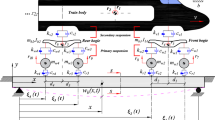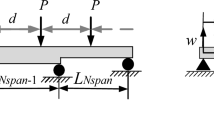Abstract
For structural analysis of bus and coach tubular structures, finite element analysis with beam type elements is widely approved and utilized. These elements have an infinitely rigid behavior at the joint level, which represents an unrealistic stiffer estimation of the modeled structures. This cannot be neglected since it introduces stiffness variations when analyzing complex structures. To overcome this limitation, in this article an alternative beam T-junction model, in which 6 elastic elements are included at the joint level in order to improve the local stiffness behavior, is utilized. A new methodology to determine these 6 elastic constants is proposed, based on the analysis of the modal response differences between the beam model and the real prototype T-junctions. In this way, a completely new methodology for the determination of the rigidity of the elastic elements based on the analysis of the modal characteristics of these structures is presented. The methodology is validated against experimental modal analysis. The results show that using this methodology with the alternative beam T-junction model is possible to obtain a more accurate T-junction model with an average deviation from real models of less than 1.5%, and a maximum deviation among the studied modes of less than 4.
Similar content being viewed by others
References
Adams, V. and Askennazi, A. (1999). Building Better Products with Finite Element Analysis. OnWord Press, Port Jefferson, NY, USA.
Ahmadian, H., Mottershead, J. and Friswell, M. I. (1996). Joint modelling for finite element model updating. 14th Int. Modal Analysis Conf. (IMAC), Dearborn, Michigan, USA.
Alcalá, E., Badea, F., Martin, Á. and Aparicio, F. (2013). Methodology for the accuracy improvement of FEM beam type T-junctions of buses and coaches structures. Int. J. Automotive Technology 14, 5, 817–827.
Debnath, N., Dutta, A. and Deb, S. K. (2012). Placement of sensors in operational modal analysis for truss bridges. Mechanical Systems and Signal Processing, 31, 196–216.
DeClerck, J. P. and Avitabile, P. (1996). Development of several new tools for modal pre-test evaluation. 14th Int. Modal Analysis Conf. (IMAC), Dearborn, MI, USA.
Eriksson, P. (2001). Optimisation of a bus body structure. Int. J. Heavy Vehicle Systems 8, 1, 1–16.
Friswell, M. I., Mottershead, J. E. and Ahmadian, H. (2001). Finite-element model updating using experimental test data: Parametrization and regularization. Philosophical Trans. Royal Society of London. Series A: Mathematical, Physical and Engineering Sciences 359, 1778, 169–186.
Gauchia, A., Diaz, V., Boada, M. J. L. and Boada, B. L. (2010). Torsional stiffness and weight optimization of a real bus structure. Int. J. Automotive Technology 11, 1, 41–4.7.
Gombor, B. (2005). Dynamic analysis of a bus body frame: Determination of the loads and stresses. Vehicle System Dynamics 43, 11, 807–822.
Horton, B., Gurgenci, H., Veidt, M. and Friswell, M. I. (2000). Finite element model updating of a welded space frame. 18th Int. Modal Analysis Conf. (IMAC), San Antonio, TX, USA
Hutton, D. V. (2004) Fundamentals of Finite Element Analysis. McGraw-Hill, New York, NY, USA.
Lan, F., Chen, J. and Lin, J. (2004). Comparative analysis for bus side structures and lightweight optimization. Proc. Institution of Mechanical Engineers, Part D: J. Automobile Engineering 218, 10, 1067–1075.
Leitner, M., Fössl, T., Stoschka, M. and Eichlseder, W. (2011). Evaluation of fillet weld properties and fatigue behaviour in dependence of welding parameters. Archives of Civil and Mechanical Engineering 11, 3, 651–660.
Liang, C. C. and Le, G. N. (2010). Analysis of bus rollover protection under legislated standards using LS-DYNA software simulation techniques. Int. J. Automotive Technology 11, 4, 495–506.
Liu, G., Zhao, X. and Huang, Y. (2015). Prediction of stress distribution along the intersection of tubular T-joints by a novel structural stress approach. Int. J. Fatigue, 80, 216–230.
Mares, C., Mottershead, J. E. and Friswell, M. I. (2006). Stochastic model updating: Part 1-theory and simulated example. Mechanical Systems and Signal Processing 20, 7, 1674–1695.
Milojevic, S. and Pesic, R. (2012). Theoretical and experimental analysis of a CNG cylinder rack connection to a bus roof. Int. J. Automotive Technology 13, 3, 497–503.
Moazed, R., Fotouhi, R., Szyszkowski, W. and Bitner, D. (2010). Welded T-joint connections of square thin-walled tubes under a multi-axial state of stress. The J. Strain Analysis for Engineering Design 45, 8, 629–646.
Moon, Y. M., Jee, T. H. and Park, Y. P. (1999). Development of an automotive joint model using an analytically based formulation. J. Sound and Vibration 220, 4, 625–640.
Romero, F. B., McWilliams, J. M., Fazio, E. A. and Izquierdo, F. A. (2014). Bayesian kriging regression for the accuracy improvement of beam modeled T-junctions of buses and coaches structures with a methodology based on FEM behavioral analysis. Int. J. Automotive Technology 15, 6, 1027–1041.
Shao, Y., Zhao, H. and Yang, D. (2017). Discussion on two methods for determining static strength of tubular T-joints at elevated temperature. Advances in Structural Engineering 20, 5, 704–721.
Tian, L. and Luo, Y. (2020). A study on the prediction of inherent deformation in fillet-welded joint using support vector machine and genetic optimization algorithm. J. Intelligent Manufacturing 31, 3, 575–596.
Zapico-Valle, J. L., Abad-Blasco, J., González-Martínez, M. P., Franco-Gimeno, J. M. and García-Diéguez, M. (2012). Modelling and calibration of a beam-column joint based on modal data. Computers & Structures, 108, 31–41.
Zienkiewicz, O. C., Taylor, R. L. and Zhu, J. Z. (2013). The Finite Element Method: Its Basis and Fundamentals. 7th Edition. Butterworth-Heinemann, Oxford, UK.
Acknowledgement
This Study was Funded by the Agencia Estatal de Investigación (Grant Retos 2018-Rti2018-095923-B-C22) and Cátedra Global Nebrija-Santander en Recuperación de Energía en el Transporte de Superficie.
Author information
Authors and Affiliations
Corresponding author
Additional information
Publisher’s Note
Springer Nature remains neutral with regard to jurisdictional claims in published maps and institutional affiliations.
Rights and permissions
About this article
Cite this article
Badea, F., Perez, J. & Olazagoitia, J. Beam T-junction Model Accuracy Improvement Based on Experimental Modal Analysis. Int.J Automot. Technol. 23, 1537–1545 (2022). https://doi.org/10.1007/s12239-022-0134-7
Received:
Revised:
Accepted:
Published:
Issue Date:
DOI: https://doi.org/10.1007/s12239-022-0134-7




